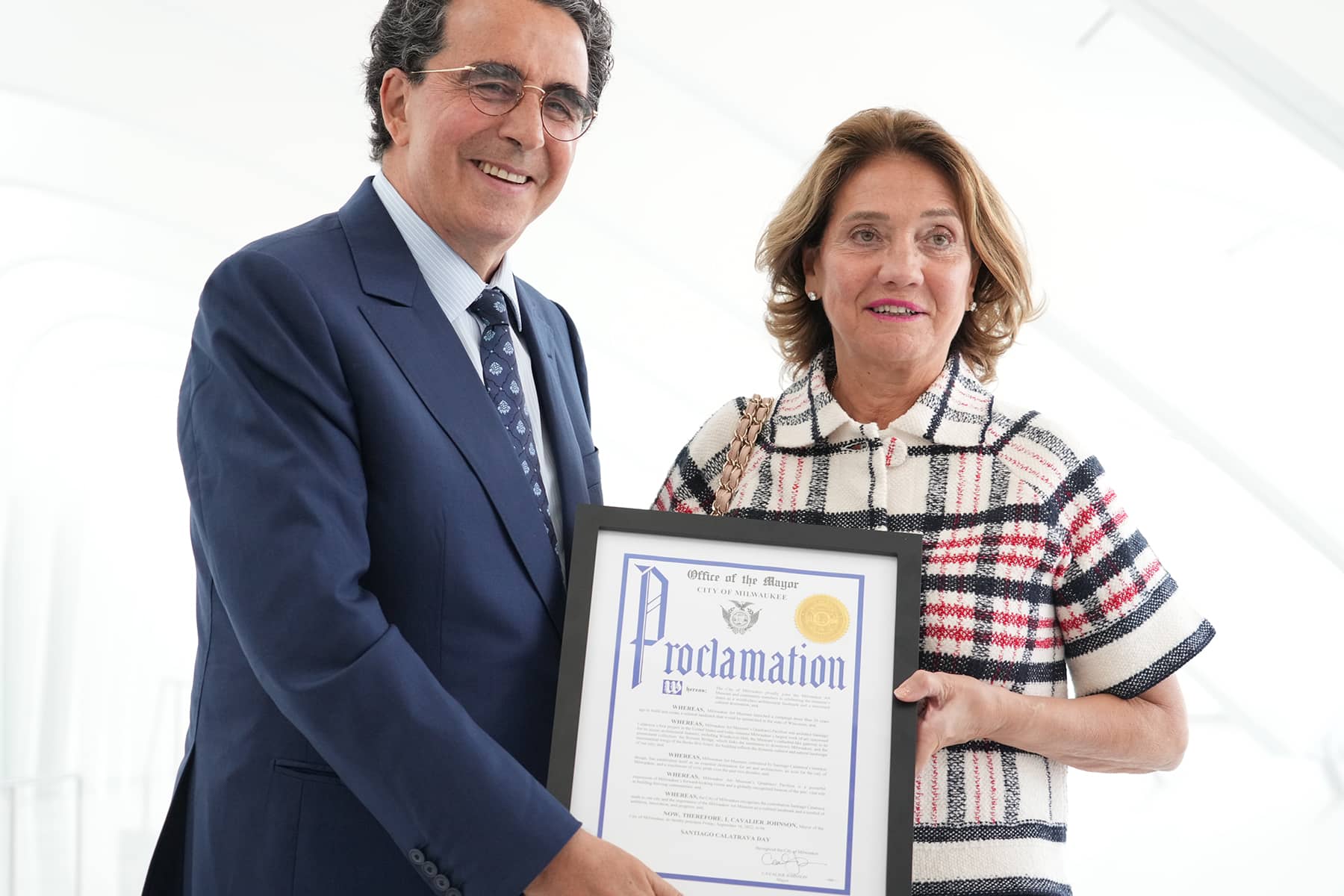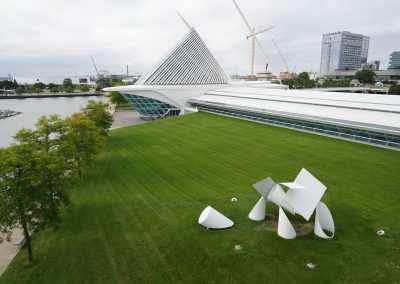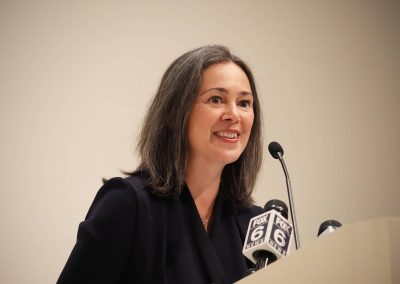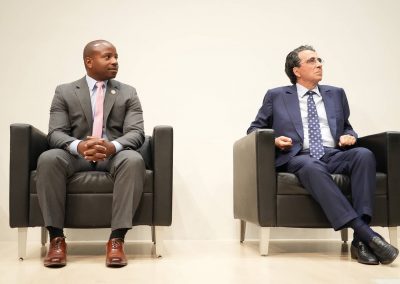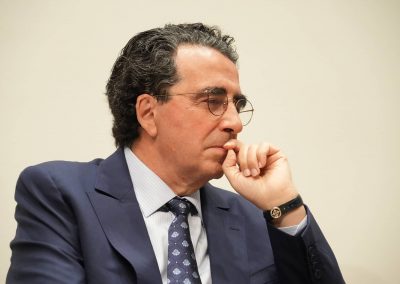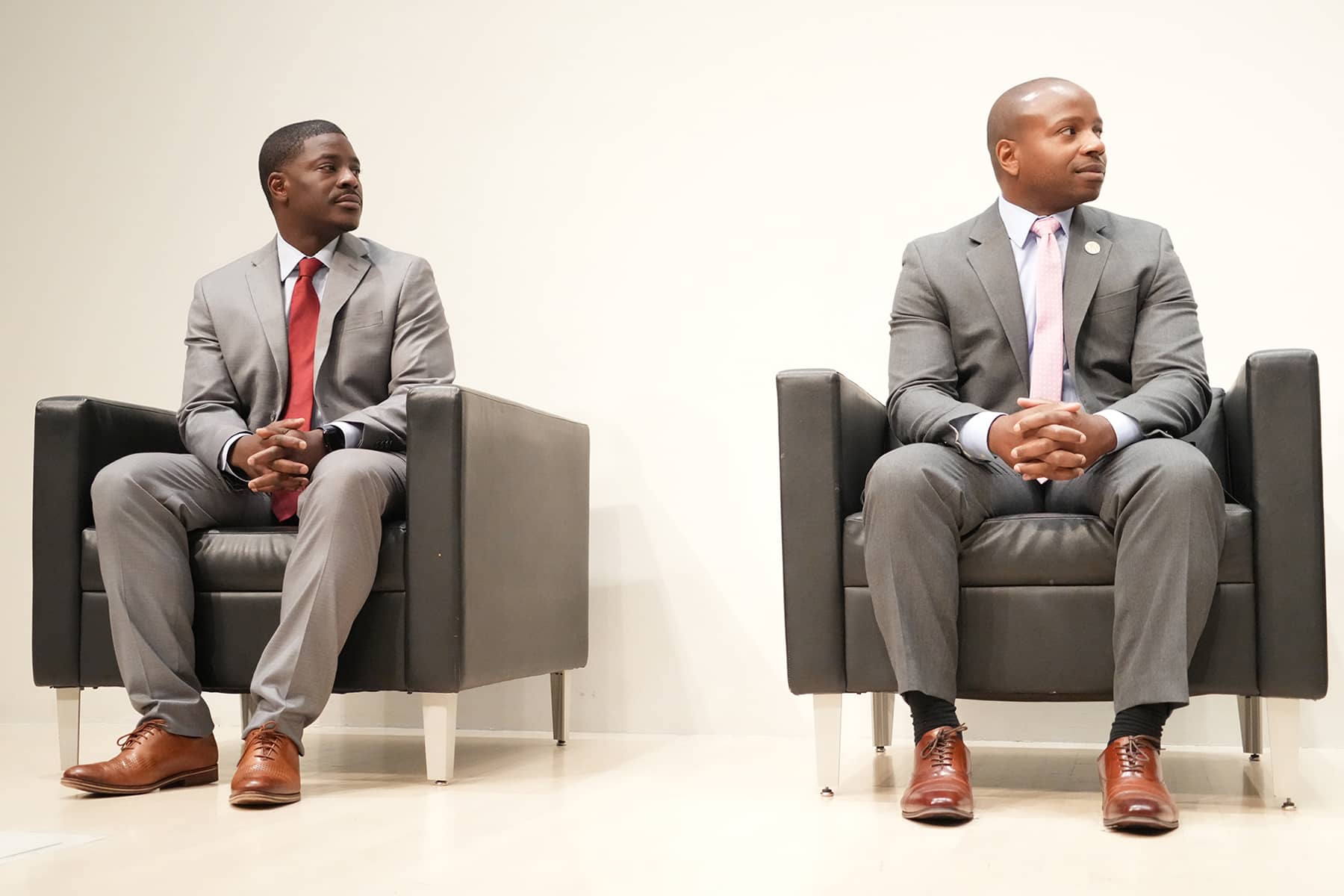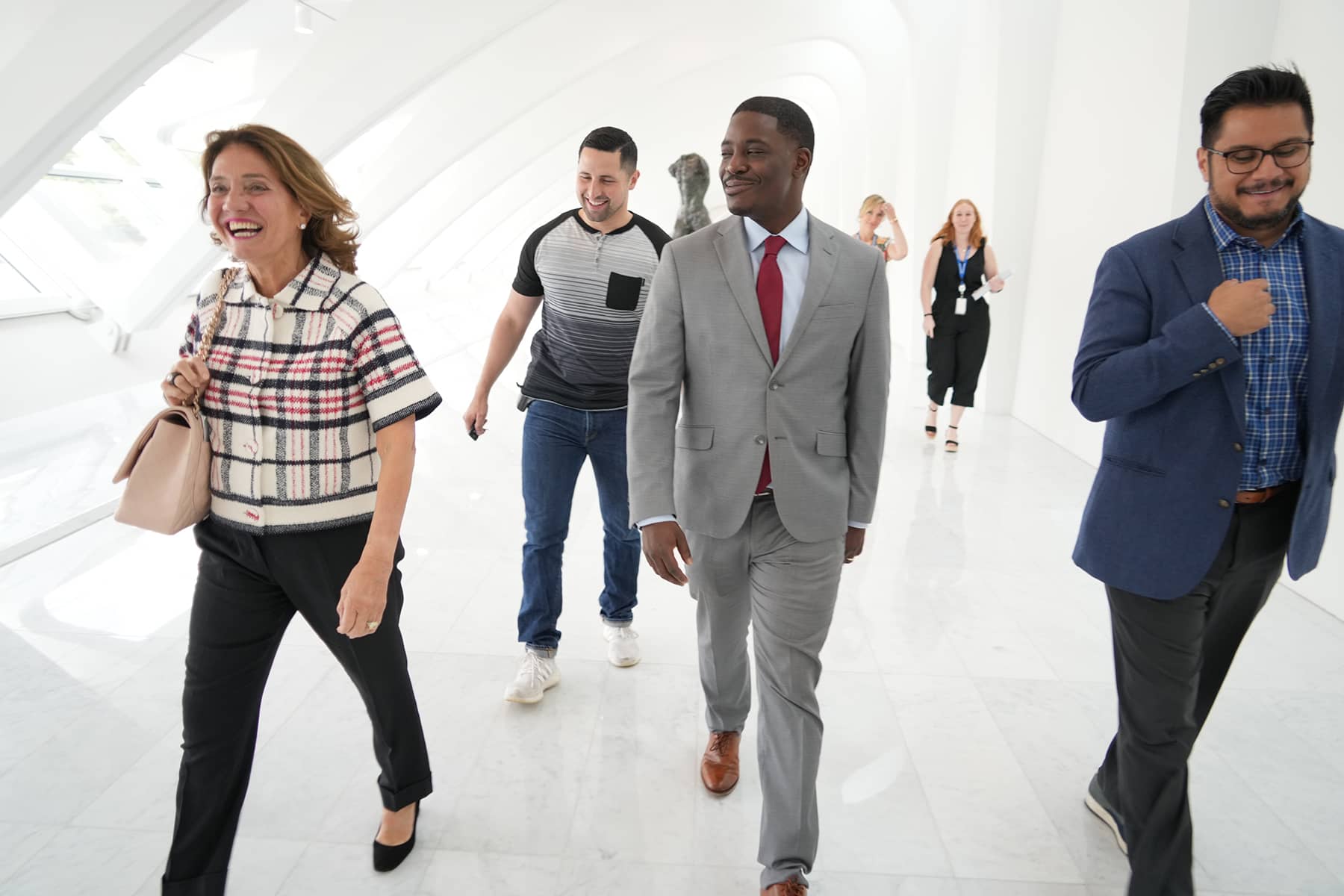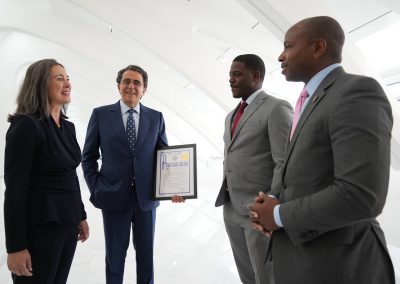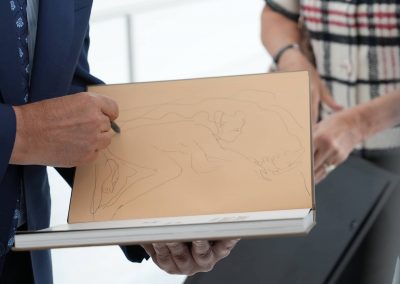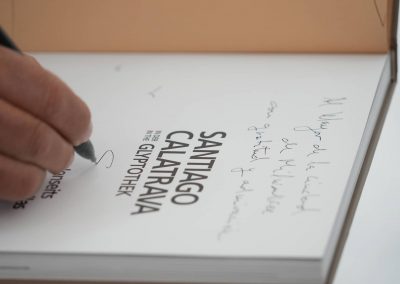
The Milwaukee Art Museum welcomed the legendary architect Santiago Calatrava back to Milwaukee for the 20th anniversary of the opening of the Quadracci Pavilion, during a press conference on September 14.
Completed in 2001 and considered the largest piece of art in Milwaukee, the Quadracci Pavilion was the Spanish architect’s first project in the United States. His visit marked the culmination of a year-long celebration of the building’s anniversary.
During his remarks, Mayor Cavalier Johnson surprised Calatrava by proclaiming Friday, September 16, 2022, as Santiago Calatrava Day throughout the city. The commemorative day was in recognition of Calatrava’s influence and significance to the City of Milwaukee.
The Mayor talked about how the Art Museum’s architecture has been used as a symbol of the city. As an icon, the structure has helped to redefine its image to local residents and the world. He also thanked Calatrava and credited his work for jump starting Milwaukee’s Renaissance.
“It is very fitting that there are wings on this building,” said Mayor Johnson. “The work that you did, it helped to give lift to the city and launch a renaissance. It gave us a new sense of pride in Milwaukee that has been going on for 20 years. It certainly will take place over the course of the next 20 years as well.”
“Milwaukee Art Museum, embodied by Santiago Calatrava’s timeless design, has established itself as an essential destination for art and architecture, an icon for the City of Milwaukee, and a touchstone of civic pride over the course of the past two decades.” – Proclamation, City of Milwaukee
In celebration of Santiago Calatrava Day, the Donna and Donald Baumgartner Director of the Milwaukee Art Museum, Marcelle Polednik invited the public to the Museum to enjoy free admission on September 16.
In 1994, the architect, Spanish artist, and engineer was chosen to design an addition to the Milwaukee Art Museum. It was Calatrava’s first project in the United States. Construction began in 1997 and was finished four years later. The Quadracci Pavilion opened in October 2001, combining the latest technology with the strong craft tradition of Milwaukee.
Calatrava proposed a pavilion-type construction on the axis with Wisconsin Avenue, the main street of the city center. Conceived as an independent entity, the pavilion contrasts with the existing set in both geometry and materials, a white form of steel and concrete reminiscent of a ship.
“The 20th anniversary is truly an opportunity to reflect on what this building has meant to the Milwaukee Art Museum, to our community and to the country,” said Polednik. “In his writings about his architecture, Mr. Calatrava often considers the notion of the movement of light and space on buildings, and what an emotional power that movement can have on those who experienced those qualities firsthand. He wrote, ‘when a building projects lightness on its structure, it has the capacity to elevate all those who encounter it.’ And it has truly done that in our community.”
Polednik said that Milwaukee residents who walked into the Quadracci Pavilion felt a sense of pride, awe, inspiration, and aspiration. The 13,197 m2 structure commands panoramic views towards the lake, and houses a large reception hall, gallery space for temporary exhibitions, an educational center with a conference room, the Lubar Auditorium with 300 seats, and meeting spaces.
“Back in 1994, when we began this process, we thought that we would be getting a beautiful building,” added Polednik. “And at the end of the day, what we received as a gift from Mr. Calatrava was a sense of destiny. A sense of purpose. A sense of hope and aspiration for our community. A sense of aspiration that we have yet to fulfill, but that’s the good news. That’s the work of the next 20 years and beyond.”
In proclaiming Santiago Calatrava Day, the city of Milwaukee recognized how, over the past two decades, Calatrava’s building has established the Milwaukee Art Museum as a preeminent destination for art and architecture, an icon for the city of Milwaukee, and a touchstone of civic pride.
“I am by no means any type of artists or expert, but I’ve always believed art has the power to inspire and the potential to try to transcend,” said said Milwaukee County Executive David Crowley. “And so the pavilion has been a part of the cityscape for more than 20 years. During that time, it has inspired us, it has made us proud as a community, and it has transcended our city. And today, I think we can all agree that it is ingrained in Milwaukee’s DNA.”
To design the sculptural Quadracci Pavilion, Calatrava took into account the original building of Eeron Saarinen, the topography of the city, and the Prairie style of Frank Lloyd Wright.
Since the Pavilion’s debut, the Art Museum has been ranked among Conde Nast Traveler’s “New Wonders of the World,” and lauded by People Magazine as one of the “New American Beauties” and an “instant tourist attraction.” With the Quadracci Pavilion, Calatrava designed not only an internationally celebrated architectural feat, but a lasting symbol of innovation, inspiration, and momentum for the City of Milwaukee.
“I’m speechless. Let me say thank you, this is something completely unexpected and it is a great honor. As an architect who works here and there, something like this has never happened to me,” said Calatrava. “Entering the museum, it was for me like the opening day. It has been so beautifully preserved with so much care. That is very important. It means respect to the work, respect to all the people who has been working here.”
Calatrava talked about walking through the building and seeing himself in the design, remembering every curve and small detail. Even before construction began, Calatrava fell in love with Milwaukee, and how accepting the people were to him. He credited that to the city’s unique immigrant history. From that experience, he was inspired to make a permanent home for his family in America.
In May 2017, Calatrava’s “S2” sculpture was installed by the Chase Tower at Water Street and Wisconsin Avenue as part of Sculpture Milwaukee, which has exhibited artwork artwork in public spaces downtown for several years.
> Read: Calatrava’s sculpture and how Milwaukee street art gets installed
Calatrava’s designs are often inspired by nature and present a combination of organic forms and technological innovation. The expansion of the Milwaukee Art Museum incorporates multiple elements inspired by its location facing the lake. Among the many maritime elements in the design are: mobile steel blinds inspired by the wings of a bird, a wired pedestrian bridge with a raised mast inspired by the shape of a sailboat and a curved gallery of a single floor reminiscent of a wave.
“Instead of just adding something to existing buildings, I also wanted to add something to the front of the lake. Therefore, I have worked to infuse the building with a certain sensitivity to the culture of the lake: ships, sails and ever changing landscape,” said Calatrava.
He has stated that the design of the Quadracci Pavilion “responds to the culture of the lake: the sailboats, the weather, the sensation of movement and change.” And “in the coronation element of the brise soleil, the shape of the building is both formal, completing the composition; functional, controlling the level of light; symbolic, opening to receive visitors, and iconic, creating a memorable image for the Museum and the city.
After the press conference, Calatrava gave the Mayor Johnson book as a gift. Along with a personalized inscription and autograph, he illustrated on the spot a drawing of a woman releasing a bird. The book Santiago Calatrava in the Glyptothek Beyond Hellas detailed his work, and was recently published on August 25.
© Photo
Lee Matz






